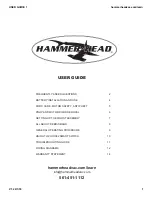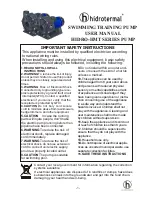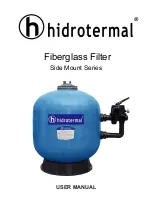
Read and Follow All Safety Information and
Instructions.
Keep for future reference.
Failure to follow these warnings and instructions
can result in serious injury or death to users,
especially children.
S-S-004523
1
OWNER’S MANUAL
Prevent Drowning
Closely watch children who are
in or near
this pool.
Children under 5 are at highest risk for drowning.
Empty pool after use.
WARNING
• Children, especially children younger than 5 years, are at high
risk of drowning.
• Drowning occurs silently and quickly and can occur in as little
as 2 in. (5cm) of water.
• Keep children in your direct sight, stay close, and actively
supervise them when they are in or near this pool and when
you are filling and emptying this pool.
• When searching for a missing child, check the pool first, even if
child is thought to be in the house.
• Empty pool completely after each use and store the empty pool
in such a way that it does not collect water from rain or any
other source.
Drowning Risk:
• Keep unsupervised children from accessing the pool by
installing fencing or other approved barrier around all sides of
the pool. State or local laws or codes may require fencing or
other approved barriers. Check state or local laws and codes
before setting up the pool. Refer to the list of barrier
recommendations and guidelines as described in CPSC
Publication No.362.
• Do not leave toys inside pool when finished using, since toys
and similar items might attract a child to the pool.
• Position furniture (for example, tables, chairs) away from pool
and so that children cannot climb on it to gain access to the
pool.
• After using the pool, remove water to a level of 1/2 in. (1cm) or
less.
Diving Risk:
• Do not dive into the pool. Diving into shallow water can result in
a broken neck, paralysis, or death.
Electrocution Risk:
• Keep all electrical lines, radios, speakers and other electrical
appliances away from the pool.
• Do not place pool near or under overhead electrical lines.
First Aid:
• Keep a working phone and a list of emergency numbers near
the pool.
• Become certified in cardiopulmonary resuscitation (CPR). In the
event of an emergency, immediate use of CPR can make a
life-saving difference.
Safety Barrier Guidelines for Residential Swimming Pool
Section I:
Outdoor swimming pool
An outdoor swimming pool, including an inground, aboveground,
or onground pool, hot tub, or spa, should be provided with a
barrier which complies with the following:
1. The top of the barrier should be at least 48 inches above
grade measured on the side of the barrier which faces away
from the swimming pool. The maximum vertical clearance
between grade and the bottom of the barrier should be
4 inches measured on the side of the barrier which faces
away from the swimming pool. Where the top of the pool
structure is above grade, such as an aboveground pool, the
barrier may be at ground level, such as the pool structure, or
mounted on top of the pool structure. Where the barrier is
mounted on top of the pool structure, the maximum vertical
clearance between the top of the pool structure and the
bottom of the barrier should be 4 inches.
2. Openings in the barrier should not allow passage of a 4-inch
diameter sphere.
3. Solid barriers, which do not have openings, such as a
masonry or stone wall, should not contain indentations or
protrusions except for normal construction tolerances and
tooled masonry joints.
4. Where the barrier is composed of horizontal and vertical
members and the distance between the tops of the
horizontal members is less than 45 inches, the horizontal
members should be located on the swimming pool side of
the fence. Spacing between vertical members should not
exceed 1-3/4 inches in width. Where there are decorative
cutouts, spacing within the cutouts should not exceed
1-3/4 inches in width.
5. Where the barrier is composed of horizontal and vertical
members and the distance between the tops of the
horizontal members is 45 inches or more, spacing between
vertical members should not exceed 4 inches. Where there
are decorative cutouts, spacing within the cutouts should not
exceed 1-3/4 inches in width.
6. Maximum mesh size for chain link fences should not exceed
1-3/4 inch square unless the fence is provided with slats
fastened at the top or the bottom which reduce the openings
to no more than 1-3/4 inches.
7. Where the barrier is composed of diagonal members, such
as a lattice fence, the maximum opening formed by the
diagonal members should be no more than 1-3/4 inches.
8. Access gates to the pool should comply with Section I,
Paragraphs 1 through 7,and should be equipped to
accommodate alocking device. Pedestrian access gates
should open outward, away from the pool, and should be
self-closing and have a self-latching device. Gates other
than pedestrian access gates should have a self-latching
device. Where the release mechanism of the self-latching
device is located less than 54 inches from the bottom of the
gate, (a) the release mechanism should be located on the
pool side of the gate at least 3 inches below the top of the
gate and (b) the gate and barrier should have no opening
greater than 1/2 inch within18 inches of the release
mechanism.
9. Where a wall of a dwelling serves aspart of the barrier, one of
the following should apply:
(a) All doors with direct access to the pool through that wall
should be equipped with an alarm which produces an
audible warning when the door and its screen, if present,
are opened. The alarm should sound continuously for a
minimum of 30 seconds within 7 seconds after the door is
opened. Alarms should meet the requirements of UL2017
General-Purpose Signaling Devices and Systems,
Section 77. The alarm should have a minimum sound
pressure rating of 85 dBA at 10 feet and the sound of the
alarm should be distinctive from other household sounds,
such as smoke alarms, telephones, and door bells. The
alarm should automatically reset under all conditions. The
alarm should be equipped with manual means, such as
touchpads or switches, to temporarily deactivate the
alarm for a single opening of the door from either
direction. Such deactivation should last for nomore than
15 seconds. The deactivation touchpads or switches
should be located at least 54 inches above the threshold
of the door.
(b) The pool should be equipped with a power safety cover
which complies with ASTM F1346-91 listed below.
(c) Other means of protection, such as self-closing doors with
self-latching devices, are acceptable so long as the
degree of protection afforded is not less than the
protection afforded by (a) or (b) described above.
10. Where an aboveground pool structure is used as a barrier or
where the barrier is mounted on top of the pool structure,
and the means of access is a ladder or steps, then (a) the
ladder to the pool or steps should be capable of being
secured, locked or removed to prevent access, or (b) the
ladder or steps should be surrounded by a barrier which
meets Section I, Paragraphs 1 through 9. When the ladder
or steps are secured, locked, or removed,any opening
created should not allow the passage of a 4-inch diameter
sphere.
Section II:
Barrier Locations
Barriers should be located so as to prohibit permanent
structures, equipment or similar objects from being used to climb
the barriers.
Summary of Contents for 53026
Page 9: ...S S 004523 9...




























